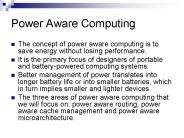The Power of Computers - PowerPoint PPT Presentation
Title:
The Power of Computers
Description:
The Power of Computers Changing the Way Teachers Engage Students by Heather Schilling EDTEC 670 Dr. Mullen 22 July 2005 Background Issues Schools acknowledge ... – PowerPoint PPT presentation
Number of Views:31
Avg rating:3.0/5.0
Title: The Power of Computers
1
The Power of Computers
- Changing the Way Teachers Engage Students
- by
- Heather Schilling
- EDTEC 670 Dr. Mullen
- 22 July 2005
2
Background Issues
- Schools acknowledge importance of computers in
classrooms nearly 100 have Internet access - Only a handful of educators fully integrate
computers - Most use computers as glorified typewriters (Rod
Paige, Jan 2005) - Megachanges are occurring all around, but the
process of teaching has not changed substantially
over the past 100 years (Ferguson)
3
Obstacles to Full Integration
- Time
- Lack of dialogue about learning processes
computers can open this dialogue - No Child Left Behind accountability
everything must be scientifically researched
difficulty in distinguishing impact of computers
on student learning - Rod Paige consulted 200,000 children to
create the National Education Technology Plan
4
Key Elements Shaping Computer Use
- International Society for Technology in Education
has created National Educational Technology
Standards - Create important guidelines, profiles, and
standards for technologically prepared teachers
and students - Major implications for teacher prep programs
5
The Focus
- Society sees the importance of computers
- Major focus must be on the teaching philosophy of
educators - Look to Constructivism -
6
Atticus High School Revisited
- Rural high school of 548 students in grades 9 12
- Large amount of money spent on computers
- Specific technology plan in place
- Only a small handful use computers in the fullest
extent - How can Atticus encourage more of its teachers to
approach teaching like Mr. Clark?
7
Seymour Papert
- The Childrens Machine Rethinking School in the
Age of the Computer (1993) - Avoids term constructivism hasnt been
successful in transforming education - Uses term constructionism and mathetics
- Constructionism connotation of construction
set - Mathetics from Greek family of to learn
represents the essence of learning
8
Paperts Criticism
- Traditional, hierarchical schools smother teacher
creativity and enthusiasm - We have failed to truly transform the paradigm of
how we approach learning
9
Teacher Preparation Programs
- Oswego State University New York
- Goals 2000 Preservice Tehcnology Infusion Project
- Integration of technology into teacher prep
program- collaboration between public school
teachers, college professors, and future teachers - Between 1st and 2nd years instructional methods
of technology rose from 15.9 to 68.9
10
What we learn from Oswego
- Preservice teachers want more technology infusion
- Teacher educators and content methods teachers
must model this - Preservice teachers transformed their view of
their role as teachers from dispenser to
facilitator
11
Supporting Veteran Teachers
- Provide adequate training
- Teachers must be allowed to learn and play with
the technology at least 35-50 hours before it
becomes - Paradigm shift
- Papert (1993) says School does not have in its
institutional mind that teachers have a creative
role (p. 70) - That is untrue examples from Paperts writing
and Atticus High School - Move away from hierarchical model of schools
12
Supporting Veteran Teachers continued
- Allow small groups of teachers to collaborate and
create their own learning environment within a
school small school - Opportunities to discuss and collaborate
develop the sense that taking instructional
risks and trying some alternative ways of
instruction is acceptable and encouraged
(Goldman and others, 1999, p. 33)
13
Conclusions
- Computers have the possibility to transform how
we teach and how we learn - We must step away from the current paradigm that
binds us - We must embrace a constructivist or
constructionist approach to teaching - Teacher prep programs and administration is key
in helping promote this philosophy of teaching - Standardized testing is here move on!































